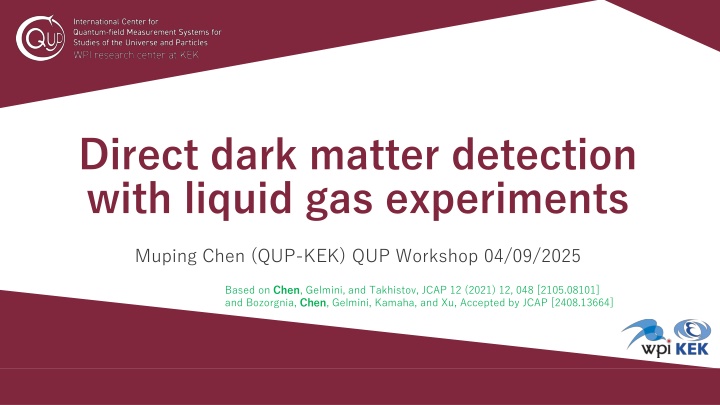
Dark Matter Detection with Liquid Gas Experiments
Explore the latest developments in direct dark matter detection with liquid gas experiments, including insights on DM-electron interaction and halo-independent methods. Discover how loop-level corrections and differential rate comparisons enhance our understanding of dark matter interactions. Stay informed on cutting-edge research in the field.
Uploaded on | 0 Views
Download Presentation

Please find below an Image/Link to download the presentation.
The content on the website is provided AS IS for your information and personal use only. It may not be sold, licensed, or shared on other websites without obtaining consent from the author. If you encounter any issues during the download, it is possible that the publisher has removed the file from their server.
You are allowed to download the files provided on this website for personal or commercial use, subject to the condition that they are used lawfully. All files are the property of their respective owners.
The content on the website is provided AS IS for your information and personal use only. It may not be sold, licensed, or shared on other websites without obtaining consent from the author.
E N D
Presentation Transcript
Direct dark matter detection with liquid gas experiments Muping Chen (QUP-KEK) QUP Workshop 04/09/2025 Based on Chen, Gelmini, and Takhistov, JCAP 12 (2021) 12, 048 [2105.08101] and Bozorgnia, Chen, Gelmini, Kamaha, and Xu, Accepted by JCAP [2408.13664]
Direct detection with liquid gas(Xe, Ar) Current liquid gas experiments also detect dark matter(DM)-electron interaction International Center for Quantum-field Measurement Systems for Studies of the Universe and Particles (QUP) 2
Conventional analysis Assumed halo function Given interaction model Results shown in plane Understanding implications for a particular model Model-dependent comparisons of different results Snowmass 2021 [2203.08297] International Center for Quantum-field Measurement Systems for Studies of the Universe and Particles (QUP) 3
Halo-indepedent method First developed by Fox, Liu and Weiner Fox, Liu and Weiner, PRD 83, 103514 (2011), [1011.1915] Formalism for calculating developed by Gelmini et al.Gelmini et al, JCAP 12 (2017) 039 [1707.07019] Reducing Astrophysical uncertainty Compare two results in a astrophysics-independent manner Infer local DM halo velocity distribution International Center for Quantum-field Measurement Systems for Studies of the Universe and Particles (QUP) 4
New DM-electron scattering Analysis Graphs are rescaled, the maximum is 1. Window : ????range in which the reponse function is significantly different from 0. Direct detection data can give information on the local dark halo within the window. Chen, Gelmini, and Takhistov, JCAP 12 (2021) 12, 048 [2105.08101] International Center for Quantum-field Measurement Systems for Studies of the Universe and Particles (QUP) 5
Loop-level Correction Compare Xe and Ar detection capability due to a pseudoscalar mediator Loop-level correction must be included Xe: Nonzero nuclear spin, tree-level + loop-level Ar: Zero nuclear spin, loop- level only Ertas and Kahlhoefer, JHEP 06 (2019) 052, [1902.11070] International Center for Quantum-field Measurement Systems for Studies of the Universe and Particles (QUP) 6
Differential rate comparison Bozorgnia, Chen, Gelmini, Kamaha, and Xu, Accepted by JCAP [2408.13664] International Center for Quantum-field Measurement Systems for Studies of the Universe and Particles (QUP) 7
Events comparison Bozorgnia, Chen, Gelmini, Kamaha, and Xu, Accepted by JCAP [2408.13664] International Center for Quantum-field Measurement Systems for Studies of the Universe and Particles (QUP) 8
Significance comparison DarkSide-LowMass (DS-LSM) and LUX-ZEPLIN (LZ) DS-M: P. Agnes et al.,Phys.Rev.D 107 (2023) 11, 112006 [2209.01177] LZ: B. J. Mount et al., [1703.09144] Bozorgnia, Chen, Gelmini, Kamaha, and Xu, Accepted by JCAP [2408.13664] International Center for Quantum-field Measurement Systems for Studies of the Universe and Particles (QUP) 9
Summary Halo-indepedent analysis can infer local DM halo properties and compare experimental results, free of astrophysical uncertainties. Response function acts as a window through which direct detection data can give information on the local dark halo. Different experiments sensitive to partially overlapping velocity ranges would be needed to enable a more detailed inference of the DM distribution. At loop-level there are spin-indepedent terms that can be detected by Ar. Ar-based DS-LM experiment generally requires larger exposure to reach a sensitivity similar to that of the Xe-based LZ experiment. Only for a small region of parameter space (??~GeV, ??~1 3) in which the Ar-based experiment is favored and can reach a sensitivity which is ~10 times better than the Xe-based experiment. International Center for Quantum-field Measurement Systems for Studies of the Universe and Particles (QUP) 10
Thank you for listening International Center for Quantum-field Measurement Systems for Studies of the Universe and Particles (QUP) 11
